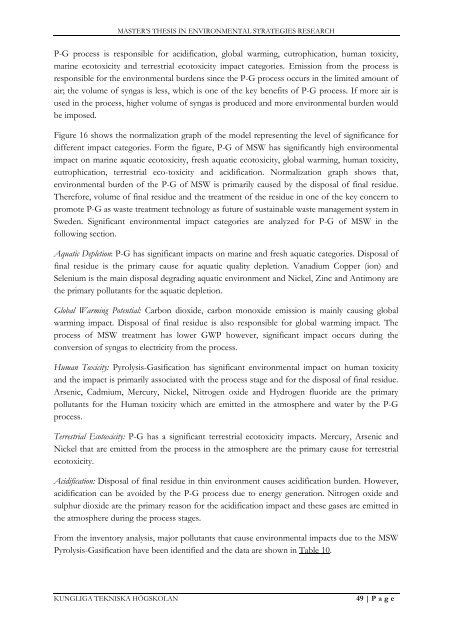Technical Development of Waste Sector in Sweden: Survey
Technical Development of Waste Sector in Sweden: Survey
Technical Development of Waste Sector in Sweden: Survey
Create successful ePaper yourself
Turn your PDF publications into a flip-book with our unique Google optimized e-Paper software.
MASTER’S THESIS IN ENVIRONMENTAL STRATEGIES RESEARCH<br />
P-G process is responsible for acidification, global warm<strong>in</strong>g, eutrophication, human toxicity,<br />
mar<strong>in</strong>e ecotoxicity and terrestrial ecotoxicity impact categories. Emission from the process is<br />
responsible for the environmental burdens s<strong>in</strong>ce the P-G process occurs <strong>in</strong> the limited amount <strong>of</strong><br />
air; the volume <strong>of</strong> syngas is less, which is one <strong>of</strong> the key benefits <strong>of</strong> P-G process. If more air is<br />
used <strong>in</strong> the process, higher volume <strong>of</strong> syngas is produced and more environmental burden would<br />
be imposed.<br />
Figure 16 shows the normalization graph <strong>of</strong> the model represent<strong>in</strong>g the level <strong>of</strong> significance for<br />
different impact categories. Form the figure, P-G <strong>of</strong> MSW has significantly high environmental<br />
impact on mar<strong>in</strong>e aquatic ecotoxicity, fresh aquatic ecotoxicity, global warm<strong>in</strong>g, human toxicity,<br />
eutrophication, terrestrial eco-toxicity and acidification. Normalization graph shows that,<br />
environmental burden <strong>of</strong> the P-G <strong>of</strong> MSW is primarily caused by the disposal <strong>of</strong> f<strong>in</strong>al residue.<br />
Therefore, volume <strong>of</strong> f<strong>in</strong>al residue and the treatment <strong>of</strong> the residue <strong>in</strong> one <strong>of</strong> the key concern to<br />
promote P-G as waste treatment technology as future <strong>of</strong> susta<strong>in</strong>able waste management system <strong>in</strong><br />
<strong>Sweden</strong>. Significant environmental impact categories are analyzed for P-G <strong>of</strong> MSW <strong>in</strong> the<br />
follow<strong>in</strong>g section.<br />
Aquatic Depletion: P-G has significant impacts on mar<strong>in</strong>e and fresh aquatic categories. Disposal <strong>of</strong><br />
f<strong>in</strong>al residue is the primary cause for aquatic quality depletion. Vanadium Copper (ion) and<br />
Selenium is the ma<strong>in</strong> disposal degrad<strong>in</strong>g aquatic environment and Nickel, Z<strong>in</strong>c and Antimony are<br />
the primary pollutants for the aquatic depletion.<br />
Global Warm<strong>in</strong>g Potential: Carbon dioxide, carbon monoxide emission is ma<strong>in</strong>ly caus<strong>in</strong>g global<br />
warm<strong>in</strong>g impact. Disposal <strong>of</strong> f<strong>in</strong>al residue is also responsible for global warm<strong>in</strong>g impact. The<br />
process <strong>of</strong> MSW treatment has lower GWP however, significant impact occurs dur<strong>in</strong>g the<br />
conversion <strong>of</strong> syngas to electricity from the process.<br />
Human Toxicity: Pyrolysis-Gasification has significant environmental impact on human toxicity<br />
and the impact is primarily associated with the process stage and for the disposal <strong>of</strong> f<strong>in</strong>al residue.<br />
Arsenic, Cadmium, Mercury, Nickel, Nitrogen oxide and Hydrogen fluoride are the primary<br />
pollutants for the Human toxicity which are emitted <strong>in</strong> the atmosphere and water by the P-G<br />
process.<br />
Terrestrial Ecotoxicity: P-G has a significant terrestrial ecotoxicity impacts. Mercury, Arsenic and<br />
Nickel that are emitted from the process <strong>in</strong> the atmosphere are the primary cause for terrestrial<br />
ecotoxicity.<br />
Acidification: Disposal <strong>of</strong> f<strong>in</strong>al residue <strong>in</strong> th<strong>in</strong> environment causes acidification burden. However,<br />
acidification can be avoided by the P-G process due to energy generation. Nitrogen oxide and<br />
sulphur dioxide are the primary reason for the acidification impact and these gases are emitted <strong>in</strong><br />
the atmosphere dur<strong>in</strong>g the process stages.<br />
From the <strong>in</strong>ventory analysis, major pollutants that cause environmental impacts due to the MSW<br />
Pyrolysis-Gasification have been identified and the data are shown <strong>in</strong> Table 10.<br />
KUNGLIGA TEKNISKA HÖGSKOLAN<br />
49 | P a g e
















